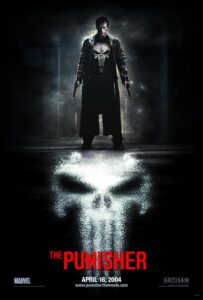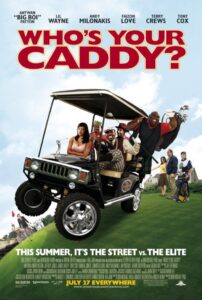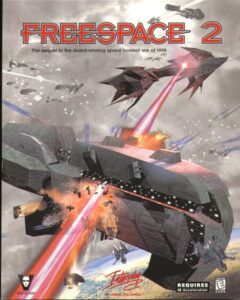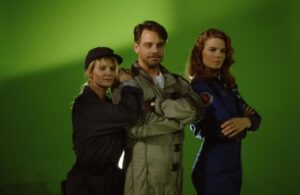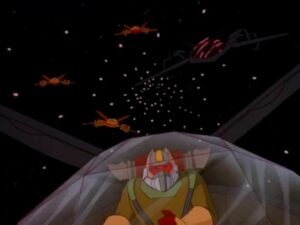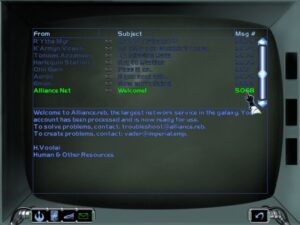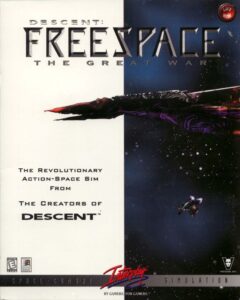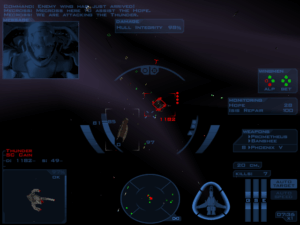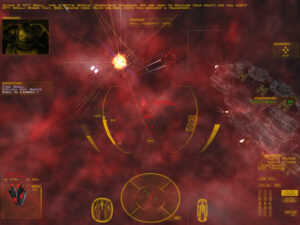Author Archives: Jimmy Maher
Mr. Roberts Goes to Hollywood, Part 2: The Producer
With the Wing Commander movie having gone down in flames, there was nothing left for Chris Roberts and the rest of Digital Anvil to do but go back to making games. This undoubtedly pleased Microsoft, which had been waiting for some return on its generous investment in what it had thought was a new games studio for more than two years now. Yet Microsoft must have been considerably less pleased by the actual states of the game projects being undertaken by Digital Anvil. For they rather belied Roberts’s repeated assurances that doing the special effects for the movie wouldn’t affect the games at all. Of the five game projects that had been begun before the movies came calling, Robert Rodriguez’s Tribe had ended with his departure and Highway Knight had also been quietly abandoned. Two of the other projects — the real-time-strategy game Conquest and the crazily ambitious alternative-life-in-a-box Freelancer — were spinning their wheels with no firm timetable.
That did at least leave Starlancer to stand out as a rare example of good sense. At the height of his brother’s movie mania, Erin Roberts had flown to Britain, to place his Starlancer design documents in the hands of a new outfit called Warthog, located in the Robertses’ old hometown of Manchester. The first tangible product to result from Microsoft’s investment in Digital Anvil would thus come from a sub-contractor rather than from the studio itself.
Starlancer shipped in April of 2000, whereupon it became clear that, while Warthog had done a competent job with it, they hadn’t been able to make it feel fresh or exciting. “An interest-killing combination of ennui and déjà vu snakes through the whole endeavor,” wrote Computer Gaming World. In terms of presentation, it most resembled a higher-resolution version of Wing Commander II, the last game in the series before digitized human actors entered the picture. It too made do with straightforward mission briefings and the occasional computer-generated cutscene. By no means ought this to have been an automatically bad thing. Yet Starlancer lacked the spark that might have let it challenge the previous year’s Freespace 2 for the title of the 1990s space sim’s crowning glory. It sold like the afterthought it felt like.
In the meantime, Chris Roberts had picked up the pieces after the disappointment of the Wing Commander movie’s reception and unleashed his prodigious capacity for enthusiasm upon the Freelancer project. As he told gaming magazines and websites throughout 1999 and 2000, his goal was to create a “detailed, dynamic, living world” — or rather a galaxy, in which you could travel from planet to planet in your customized spaceship, doing just about anything you could imagine.
Freelancer is way beyond anything I’ve done in the Wing Commander universe. It’s going to be a fully functioning, living, breathing universe with a whole ecosystem. You can see the promise in something like Privateer, but this is geometrically [exponentially?] beyond that game. It’s like building a city. [?] Compared to Privateer, the scope, the dynamic universe — it’s all 3D — is much more interesting. There’s much more intrigue the player can get involved in. Everything’s rules-based versus scripted. Commerce happens, trade happens, and piracy happens because of what’s going on in the game universe and not because of scripted events.
Freelancer could be played alone, but would well and truly come alive only when played online, as described by Computer Gaming World:
Freelancer’s multiplayer game will be a massively-multiplayer universe where thousands of players will be able to fly around and interact with each other in a variety of capacities. Digital Anvil envisions a dynamic, socially-oriented game that features the single-player game’s politics and clans as a backdrop. This multiplayer game will also permit you to ally with one of the main houses in the game, or go it alone.
Perhaps the coolest potential feature is the ability to own your own base…
Any of you reading this article who have been following the more recent career of Chris Roberts will readily recognize the themes here. Roberts is not a designer with a huge number of grand conceptual ideas, but once he has one he likes, he holds onto it like a dog does a bone.
Alas, by the summer of 2000 Microsoft was finally running out of patience. Seeing Digital Anvil’s lack of concrete progress toward finishing Freelancer as their fourth anniversary as a studio approached, the mega-corp was becoming restless. Even Erin Roberts seemed to be losing patience with his brother. With Chris’s acquiescence, he set up his own studio in Austin, called Fever Pitch Studios, to finish Digital Anvil’s long back-burnered real-time-strategy game Conquest. It would emerge in August of 2001 under the name of Conquest: Frontier Wars, the second Digital Anvil game that had had to leave its place of birth in order to come to fruition. It would prove no more successful than Starlancer, drowning in a sea of similar games.
Well before then, Microsoft reluctantly concluded that Chris Roberts, the whole reason it had invested so heavily in Digital Anvil in the first place, was the primary reason that the studio couldn’t finish a single game on its own. Still not wanting to raise a scandal the year before the Xbox launched to signal an even deeper commitment to games, it “offered” to buy Roberts out, a transaction which would give it a majority stake in the studio. On December 5, 2000, the press release went out: “Microsoft has reached a preliminary agreement to buy Digital Anvil. The acquisition will strengthen our commitment to producing top-quality PC and Xbox titles.” Roberts was to be given the face-saving ongoing role of “creative consultant” on Freelancer, but the reality was that he had been fired from his own company for his inability to keep to a schedule and hold to a plan. His time at Digital Anvil had resulted in one commercially failed and critically panned movie, plus two games that had had to be sub-contracted out to other developers in order to get them finished; both of them as well had been or would become commercial failures. Yet Chris Roberts walked away from Digital Anvil much wealthier than when he had gone in. He told the press that he would “take some time off to kind of rethink what I want to do in the interactive-entertainment field.” When he was done thinking, he would decide to go back to movies instead of games.
In the meantime, Microsoft installed a new management team down in Austin, with orders to sort through the unfocused sprawl that Freelancer had become and find out if there was a game in there that was worth saving. Perhaps surprisingly, they decided that there was, and turned the project over to a producer named Phil Wattenberger and a lead designer named Jörg Neumann, both Origin Systems alumni who had worked on the old Wing Commander games. At Microsoft’s behest, they steered Freelancer in a slightly more casual direction, making the player’s ship easily — in fact, optimally — controllable using a mouse alone. The mouse-driven approach had actually originated during Roberts’s tenure, but there it had been tied to a customizable and upgradable “Neuronet,” an onboard artificial intelligence that was supposed to let you vibe-sim your way to glory. That got jettisoned, as did many other similarly unwieldy complications. The massively-multiplayer living galaxy, for example, became a single-player or locally multiplayer one that wasn’t quite so living as once envisioned.
When it finally shipped in March of 2003, Freelancer garnered unexpectedly strong reviews; Computer Gaming World called it “the best Chris Roberts space sim Chris Roberts didn’t actually make.” But it wasn’t rewarded commensurately in the marketplace. Even with its newfound accessibility, it was hard for it to shake the odor of an anachronism of the previous decade among gamers in general; meanwhile the dwindling number of TIE Fighter and Freespace enthusiasts had a tendency to reject it for being irredeemably dumbed-down. Instead of marking the beginning of a new era for the space sim, it went down in history as a belated coda: the very last space sim to be put out by a major publisher with real promotional efforts and the hope — unrealized in this case — of relatively high sales behind it.
As for Digital Anvil: it was shut down by Microsoft once and for all in November of 2005, after completing just one more game, a painfully unoriginal Xbox shoot-em-up called Brute Force. Two games finished in almost nine years, neither of them strong sellers; the most remarkable thing about Digital Anvil is that Microsoft allowed it to continue for as long as it did.
By the time his games studio shuffled off this mortal coil, Chris Roberts had been living in Hollywood for a number of years. And he had found a way to do pretty well for himself there, albeit in a role that he had never anticipated going in.
The decade that Chris Roberts spent in Hollywood is undoubtedly the least understood period of his career today, among both his detractors and his partisans. It is no secret why: documentation of his activities during the decade in question is far thinner on the ground than during any other time. Roberts arrived in Hollywood as just another semi-anonymous striver, not as the “game god” who had given the world Wing Commander. No one in Tinsel Town was lining up to interview him, and no one in the press paid all that much attention to what he got up to. Still, we can piece together a picture of his trajectory in which we can have reasonable confidence, even if some of the details remain hazy.
Roberts moved to Hollywood in the spring of 2001 with his windfall from the Digital Anvil buyout burning a hole in his pocket. Notwithstanding the fiasco that had been Wing Commander: The Movie, he still harbored serious ambitions of becoming a director, probably assuming that his ability to finance at least part of the budget of any film he was placed in charge of would give him a leg up. He even brought a preliminary script to show around town. It was called The American Knight, being a cinematic reinterpretation of another computer game: in this case, Origin Systems’s 1995 game Wings of Glory, which was itself yet another variation on the Wing Commander theme, dealing with the life of a World War I fighter ace in the air and on the ground. In an even more marked triumph of hope over experience, Roberts also nursed a dream of making a live-action Wing Commander television series. He founded a production company of his own, called Point of No Return Films, to forward both of these agendas. January of 2002 found Point of No Return at the Sundance Film Festival; according to E! Online, they “threw an after-hours shindig that attracted 250 revelers, with Treach and De La Soul among them.” It really did help Roberts’s cause to have some money to splash around.
But Roberts soon found that the people he met in Hollywood knew Wing Commander, if they knew it at all, only as a misbegotten flop of a film. And they weren’t much more interested in his World War I movie. They were, on the other hand, always ready to talk backroom business with someone who had some number of millions in his pocket, as Roberts did. What followed was a gradual but inexorable pivot away from being a filmmaker and toward being a film enabler, one of those who secured the cash that the creative types needed to do their thing. A watershed was reached in March of 2002, when Point of No Return Films morphed into Ascendant Pictures, whose focus was to be “improving film value in foreign territories (presales), attracting top talent and film projects, and generating equity investment in films.” It wasn’t the romantic life of an auteur, but it did show that Chris Roberts was learning to talk the talk of back-office Hollywood, aided and abetted by a network of more experienced hands that he was assembling around him. Among them was a German immigrant named Ortwin Freyermuth, who would become the most important and enduring business partner of Roberts’s post-Origin career.

Ortwin Freyermuth, right, discusses a director’s cut of Das Boot with the film’s original editor Hannes Nikel circa 1997. Like Chris Roberts, Freyermuth really does love movies.
Freyermuth was renowned in the proverbial smoke-filled rooms of Hollywood for having pioneered an incredibly useful funding model for American films. It hinged on a peculiarity of German tax law that had been intended to encourage local film-making but instead wound up becoming a demonstration of the law of unintended consequences, played out on an international stage. The original rule, as implemented by the German Ministry of Finance in the 1970s, stated that any money that a German resident invested into a film production could be immediately deducted from his or her taxable income as if it was a total loss. It was hoped that this would encourage more well-heeled Germans to invest in homegrown movies, in order to combat the creeping mono-culture of Hollywood and ensure that Germans would have films to see that dealt with contemporary life in their own country. In time, this well-meaning measure would produce just the opposite result.
Enter Ortwin Freyermuth, a lawyer who enrolled at the University of California, Los Angeles, in the mid-1980s to study international copyright law. When he stumbled across the German law I’ve just described in the course of his studies, he noted with no small excitement what it didn’t say: that the films that were deemed eligible for the tax deduction had to be German films. He arranged to fund the 1990 movie The Neverending Story II almost exclusively with German money. This first experiment in the field was not so egregious compared to what would come later, given that the movie was also shot in Germany, albeit using mostly American actors. Then again, it was only a proof of concept. Freyermuth co-founded Capella Films thereafter to make German financing a veritable way of life for Hollywood. “In the best Hollywood tradition,” wrote Variety in 1994, “the company is rife with layers of relationships, both contractual and personal, here and abroad, such that an organizational chart, if one existed, would have more lines and intersections than fractal math.” Such byzantine structures, which had a way of obscuring realities upon which people might otherwise look askance, were standard operating procedure for Freyermuth.
The Freyermuth model spread throughout Hollywood as the 1990s wore on. It seemed like a win-win, both to those in California and to the Germans who were suddenly funding so many of their movies. In some cases, you could just borrow the money you wanted to invest, use your investment to reduce your taxable income dramatically, then pay off the loan from the returns a year or two later. And there was nothing keeping you from doing this over and over, year after year. Large private-equity funds emerged in Germany, pooling the contributions of hundreds of shareholders to invest them in movies, 80 percent of them made outside of the country. These Medienfonds became as ordinary as any other form of financial planning for Herr und Frau Deutschland. They were great for people on the verge of retirement: make an investment just before retiring, then enjoy the return afterward when your tax rate was lower. They were great for spreading out and reducing the tax liability that accompanied a major windfall, great for parents wishing to move money into the hands of their grown children without getting hit by high inheritance taxes. For Hollywood, meanwhile, they turned into a money spigot like no other. Insiders took to calling it “stupid German money,” because the people behind the spigot tended to take it in stride even if the films they were investing in never turned much of a profit. The real point of the investment was the tax relief; any additional profits that emerged were just gravy. The highest tax bracket in Germany at the time was about 51.5 percent. If you were in this tax bracket, then as long as you got at least half of your money back, you came out ahead.
The sheer ubiquity of these media funds placed the German people’s elected representatives in Berlin in a delicate situation; a growing number of their own constituents were benefiting from the current state of the law. Nevertheless, in 1999 the Ministry of Finance made an attempt to stop the madness. It revised the rules to bring them into closer alignment with those that governed other, superficially similar European incentive schemes: to qualify, a film now had to either be made in Germany at least partially or have a German copyright owner. (A law of this sort in Luxembourg was the reason that the Wing Commander movie had been shot in that country.) But stupid German money was now too entrenched as a modus operandi for people on either side of the Atlantic to walk away from it without putting up a fight. Artful dodgers like Ortwin Freyermuth realized that they could sell the copyright to a Hollywood production to a German media fund, whilst inserting into the sales contract a right to buy it back at a future date for an agreed-upon price. Far from being hobbled by the change in law, they realized that they could use it to charge a premium for the tax relief they were providing to the citizens of Germany. For example, the Germans paid $94 million to Paramount Pictures for the copyright to the 2001 videogame adaptation Lara Croft: Tomb Raider. When they sold it back, the Germans were paid only $83.8 million. The tax benefits were so great that it was still worth it. By now, half of all the foreign money pouring into Hollywood was coming from the single country of Germany: $1.1 billion in 2004 alone.
Despite their ongoing popularity among the well-heeled classes, the media funds became more and more controversial in Germany as the young millennium wore on. Germany was, it was more and more loudly complained, effectively subsidizing Hollywood using money that ought to have been going to roads, schools, hospitals, and defense. Stefan Arndt, the producer of the rather wonderful German movies Run Lola Run and Good Bye Lenin!, noted that he had had to go outside his homeland to finance them because his fellow citizens all had their gazes fixed so firmly on Hollywood. “It’s crazy,” he said. “Every other country in the world ties strings to its film subsidies.” Even a group of hardcore Tolkien fans sleeping in line the night of the premiere of The Return of the King, the third film in Peter Jackson’s disproportionately German-funded Lord of the Rings trilogy, thought the situation a little bit absurd when they were told about it: “I don’t think that’s good, because I think that the three films carry themselves, that they put in enough money, that it doesn’t necessarily have to be financed with taxes.”
Whether we wish to see him as a devil tempting a young Faust named Chris Roberts, or just as a savvy man of business who found a mentee he deemed well worth his time, Ortwin Freyermuth showed our once and future game developer how this particular game was played. In April of 2004, Roberts was credited onscreen for the first time in a finished wide-release film as an executive producer. As if to underscore the transition he had made from creator to enabler, it was not a terribly Chris Roberts sort of movie. The Punisher was based on a Marvel Comics character, but it was no family-friendly superhero movie either. It was a grim, dark, and brutally violent revenge fantasy that made Dirty Harry look cute and cuddly. “At the end,” wrote the late great Roger Ebert in his review, “we feel battered down and depressed, emotions we probably don’t seek from comic-book heroes.” Whatever else you can say about Wing Commander, it does care deeply about the nobler human virtues which The Punisher submerges under fountains of blood, even if Chris Roberts is often irredeemably clumsy at presenting them.
Although The Punisher may have had a B-movie attitude, it wasn’t a B-movie, any more than Wing Commander had been. It was made for a budget of $33 million, with a cast that included John Travolta. (Admittedly, he sleepwalks through his performance as if he can barely be bothered to learn his lines, but one can’t have everything.) However joyless fuddy-duddies like yours truly and Roger Ebert may find movies like this, there was and is a market for them. The Punisher earned $20 million more than it had cost to make at the box office even before the long tail of cable-television showings and home-video rentals was factored into the equation.
Chris Roberts was off and running as a backstage Hollywood player. At the Sundance Film Festival in January of 2005, his name could be seen alongside those of George Clooney and Steven Soderbergh among the producer credits for The Jacket, an arty but flawed science-fiction film starring Adrien Brody, Keira Knightley, Kris Kristofferson, and the future Agent 007 Daniel Craig, with a soundtrack by Brian Eno. Again, these names are not the stuff of B-movies.
After The Jacket, Ascendant Pictures graduated from being an ancillary source of funding to becoming one of the primary production houses behind four reasonably high-profile independent features during 2005 and 2006. None of Lord of War, The Big White, Ask the Dust, or Lucky Number Slevin has gone down in film history as a deathless classic. Yet all of them could boast of A-list actors: Nicolas Cage, Jared Leto, Ethan Hawke, Robin Williams, Holly Hunter, Woody Harrelson, Colin Farrell, Salma Hayek, Donald Sutherland, Morgan Freeman, Ben Kingsley, and Bruce Willis can all be found amongst their casts.
As you have probably guessed, all of these films were funded primarily with German money. The aggregate return on them was middling at best. Lord of War and Lucky Number Slevin did pretty well; The Big White and Ask the Dust flopped miserably. As already noted, though, the fact that most of their investors were more concerned about the tax benefits than a more conventional return on investment made this less of an issue than it might otherwise have been. Then, too, like mutual funds on the conventional stock market, the German media funds put money into many movies in order to avoid a single point of failure. A film that became an unexpected hit could easily offset two or three duds.
Chris Roberts had arrived in the Hollywood inner circle — perhaps still the outer edge of the inner circle, but still. He had come a long way from that nerdy bedroom coder who had bumped into an artist from Origin Systems one day in an Austin games shop. Now he was living in a luxury condo in the Hollywood Hills, with one live-in girlfriend and a former one stalking him. (Oddly, it would be the latter whom he would wind up marrying.) I’ve been pretty hard on Roberts in these articles, and I’m afraid I’m going to have to be so again — harder than ever, in fact — before we’re finished. But two things he most definitely is not are stupid or lazy. I wrote at the outset of this pair of articles that few people have ever stretched so thin a thread of creative talent as far as he has. Let me amend that bit of snark now by acknowledging that he could never have done so if he wasn’t smart and driven in a very different sort of way. And let me make it crystal clear as well that nothing I’ve written about Roberts’s tenure in Hollywood so far should necessarily lead us to criticize him in any but the most tempered of ways. In exploiting a loophole in German tax law for all it was worth, he wasn’t doing anything that tons of others — a full-fledged cottage industry worth of them, on both sides of the Atlantic — weren’t also doing. But there’s more to the story in his case. Chris Roberts and Ortwin Freyermuth were actually near the center of one of the biggest financial scandals in modern German history, where dubious ethics crossed over into outright fraud.
Hollywood accounting is never simple. In that spirit, Ascendant Pictures spun off another company not long after its own founding. The wholly-owned subsidiary Rising Star Pictures was created to “closely cooperate with VIP Medienfonds Film and Entertainment”; this was the largest of all the German media funds, which collected almost half a billion Euros every year from its shareholders. Rising Star’s purpose was to be VIP’s anointed agent on the left side of the Atlantic, directing that fire hose of stupid German money around Hollywood. This meant the films of Ascendant, yes, but also those of others, to which Rising Star presumably charged a brokering fee. The final incarnation of Ascendant’s website, which is for some reason still extant, claims that Rising Star was involved in the funding of fourteen films in 2003 alone. A version of their site from March of 2005, accessible today via the Internet Archive’s Wayback Machine, heavily stresses the relationship with VIP, calling Rising Star the latter’s “primary placement agent.” This was a big, big deal, given the sheer quantity of money that VIP was taking in and paying out; more than $250 million came into Rising Star from VIP during 2003. The speed and scale of Chris Roberts’s rise in Hollywood becomes even more impressive when figures like these are taken into consideration.
Unfortunately, Andreas Schmid, the head of VIP, was arrested for tax fraud in Cologne in October of 2005. It seemed that he had not been putting most of the money he collected into movies with even ostensibly German owners, as the law required. At regular intervals, Schmid dutifully gave his shareholders a list of films into which he claimed to have invested their contributions. In actuality, however, VIP used only 20 percent of their money for its advertised purpose of funding movies. Schmid deposited the remaining 80 percent into his bank, either parking it there to earn long-term interest or sending it elsewhere from there, to places where he thought he could get a higher rate of return. He then sent fake earnings reports to his shareholders. By defrauding both the government and his clients in this way, he could make a lot of money for himself and his partners in crime. There is reason to believe that Chris Roberts and Ortwin Freyermuth were among said partners, working the scam with him through Rising Star. I’ll return to that subject shortly.
For now, though, know that Schmid may have gotten so greedy because he knew the jig was soon to be up. Rumors were swirling in both Hollywood and Berlin throughout 2005 that the German Ministry of Finance had just about had enough of watching its tax money fly out of the country. The VIP Media scandal proved the last straw, if one was needed. In November of 2005, just one month after Schmid’s arrest, it was announced that blanket tax write-offs for film investments of any stripe were a thing of the past. Going forward, Hollywood would have to find another golden goose.
Even if they weren’t in on the fix, so to speak, the arrest of Schmid and the elimination of their primary funding mechanism could only have had a deleterious effect on Ascendant Pictures. Just when they had seemed to be hitting the big time, the ground had shifted beneath their feet. Those films that were already paid for by Germans could still be made, but there would be no more like them. The last Ascendant movie from the salad days to emerge from the pipeline was Outlander, their most expensive one ever and arguably also their worst one yet; not released until 2008 due to a whole host of difficulties getting it done, it managed to lose $40 million on a $47 million budget.
Deprived of the golden eggs, Ascendant blundered from lowlight to lowlight. They had to renege on a promise to Kevin Costner to line up the financing for a movie called Taming Ben Taylor, about “a grouchy, divorced man who refuses to sell his failing vineyard to the golf course next door.” Costner, who had been so excited about the movie that he had co-written the screenplay himself, sued Ascendant for $8 million for breach of contract; the case was settled in March of 2008 under undisclosed terms.
The first and only film that Ascendant helped to fund without German money only served to advertise how far down they had come in the world. Keeping with the golf theme, the low-rent Caddyshack ripoff Who’s Your Caddy?, which made Wing Commander look like Hamlet, was released in 2007 and failed to earn back its $7 million budget. It’s best remembered today for an anecdotal report that Bill Clinton loved it. By this point, Ascendant was little more than Chris Roberts and Ortwin Freyermuth; everyone else had jumped ship. (Freyermuth seems genuinely fond of Roberts. He has stuck with him through thick and thin.) The company would nominally continue to exist for another three years, but would shepherd no more movies to completion. Its final notices in the Hollywood trade press were in association with Black Water Transit, a locus of chaos, conflict, and dysfunction that culminated in a film so incoherent that it would never be released.
Over in Germany, Andreas Schmid was convicted and sentenced to six years in prison in November of 2007. Yet the fallout from the VIP scandal was still ongoing. Shortly after his conviction in criminal court, 250 former shareholders in his fund, from whom the German government was aggressively demanding the taxes they ought to have paid earlier, launched a civil lawsuit against Schmid and the UniCredit Bank of Munich, where he had been depositing the money he claimed was being used to fund movies. The case hinged on a single deceptively simple question: had the information that Schmid sent to his shareholders in the reports issued by his fund been knowingly falsified? Some of the documents from these court proceedings, which would be decided in favor of the plaintiffs on December 30, 2011, can be accessed online at the German Ministry of Justice. I’ve spent some time going over them in the hope of learning more about the role played by Roberts and Freyermuth.
It’s been a challenge because the documents in question are not the trial transcripts, transcripts of witness interviews, nor the detailed briefs one might wish to have. They are rather strictly procedural documents, used by the court to schedule its sessions, outline the arguments being made before it, and handle the other logistics of the proceedings. Nonetheless, they contain some tantalizing tidbits that point more in the direction of Roberts and Freyermuth as co-conspirators with Schmid than as his innocent victims. I’ll tell you now what I’ve been able to glean from them as a non-lawyer and non-accountant. I’ve also made them available for download from this site, for any readers who might happen to have a more nuanced command of the German language and German law than I do.
The claimants in the lawsuit show great interest in Ascendant’s daughter company Rising Star, which they believe had no legitimate reason for existing at all, a judgment which is confirmed by the court in a preliminary draft of the final ruling. A document dated June 27, 2008, contains the startling charge that Rising Star “never produced films, but were merely an intermediary layer used for concealment,”[1]Diese produzierten nie Filme, sondern waren lediglich eine zur Verschleierung eingeschaltete Zwischenebene. citing emails written by Chris Roberts and Ortwin Freyermuth to Andreas Schmid between 2003 and 2005 that have been submitted into evidence. (Sadly, they are not included among these papers.) Another document, dated May 15, 2009, calls Rising Star “an artificially imposed layer.”[2]Eine künstlich dazwischen geschaltete Ebene. The final judgment concludes that Rising Star was an essential conduit of the fraud. What with Rising Star being “the primary placement agency for VIP,” as was acknowledged on the Ascendant website, all of the money passed through it. But instead of putting the entirety of the money into movies, it only used 20 percent of it for that purpose, funneling the rest of it back to the UniCredit Bank of Munich, Andreas Schmid’s co-defendant in the shareholder lawsuit. Even the 20 percent that stayed in Hollywood was placed with other production companies that took over the responsibility of overseeing the actual movies. Rising Star, in other words, was nothing but a shell company, a false front for getting the money from the investment fund into Schmid’s bank.
Both Roberts and Freyermuth were interviewed at least once, presumably in the United States, by investigators from the Munich Public Prosecutor’s Office; this must have been done in the run-up to Schmid’s earlier, criminal trial. They were witnesses in that trial rather than defendants, yet the facts from their testimony that are cited here leave one wondering why that should be the case. From a document dated May 15, 2009: “The structure provided by VIP was a ‘pro forma transaction,’ solely intended to achieve a certain tax advantage. This was also explained by witness Freyermuth.”[3]Die von VIP vorgegebene Struktur sei ein „Pro-Forma-Geschäft“ gewesen, alleine mit der Zielsetzung einen gewissen Steuervorteil zu erreichen. Dies habe auch der Zeuge Freyermuth so erläutert. The claimants cite the testimony of Roberts and Freyermuth as evidence that “the fund managers therefore instructed their American partners to submit inflated estimates.”[4]Die Fondsverantwortlichen hätten deshalb ihre amerikanischen Partner veranlasst, überhöhte Schätzungen abzugeben. Likewise, it is written that Roberts and Freyermuth confessed to a falsified “profit distribution for the film Perfume: The Story of a Murderer, which, according to the fund’s information, was 45 percent produced by VIP. In reality, the profit distribution did not correspond to the alleged 45-percent co-production share; it was significantly less favorable.”[5]Insoweit greift die Klageseite auf eine Gewinnverteilung (sog „waterfall“) für den Film „Das Parfum“ zurück, der nach den Fondsangaben zu 45 % von VIP 4 produziert worden sei (sog. Coproduktion). Tatsächlich habe die Gewinnverteilung keinesfalls dem angeblichen Co.-Produktionsanteil von 45 % entsprochen, sie sei wesentlich ungünstiger gewesen. Even with the most open of minds, it is very hard to read statements like this and conclude that Chris Roberts and Ortwin Freyermuth were anything other than active, willing co-conspirators in a large-scale, concerted fraud perpetrated on German investors and ordinary taxpayers.
In a document dated May 17, 2010, it is stated that Freyermuth and Roberts are being summoned to appear as witnesses before this court, on the morning and afternoon respectively of July 16, 2010. But a report dated July 8, 2010, states that “the hearing scheduled for July 16, 2010, is cancelled after witness Freyermuth informed the court that he could not appear on such short notice, and the summons for witness Chris Roberts was returned to the court as undeliverable.”[6]Der Termin vom 16. Juli 2010 wird aufgehoben, nachdem der Zeuge Freyermuth mitgeteilt hat, nicht so kurzfristig erscheinen zu können, und die Ladung des Zeugen Chris Roberts als unzustellbar wieder in den Gerichtseinlauf gekommen ist. On August 3, 2010, the court states that they will be ordered to appear again, this time on September 20, 2010, saying that Freyermuth will be told to inform Roberts, who apparently still cannot be reached, about the summons.[7]Zu diesem Termin sind die Zeugen Freyermuth und Roberts, letzterer über Freyermuth, zu laden. However, the paper trail ends there. It seems most likely that the two never did come to Munich to answer questions before the court.
Assuming all of this really is as bad as it looks, the final question we are left with is why and how Roberts and Freyermuth escaped prosecution. This question I cannot even begin to answer, other than to say that international prosecutions for financial malfeasance are notoriously difficult to coordinate and carry off. Perhaps the German authorities decided they had the ringleader in Andreas Schmid, and that was good enough. Perhaps Roberts and Freyermuth were given immunity in return for their testimony about the mechanics of the fraud in the United States. Or maybe there were some extenuating circumstances of which I am not aware, hard as it is to imagine what they might be.
In July of 2010, Roberts and Freyermuth sold Ascendant Pictures and all of its intellectual property to a film studio, film school, film distributor, real-estate developer, venture-capital house, and children’s charity — never put all your eggs in one basket! — called Bigfoot, located in, of all places, the Philippines. Roberts had left Hollywood some weeks or months before this transaction was finalized; thus the undeliverable court summons from Germany, addressed to the old Ascendant office. I do not know whether or how much he and Freyermuth ended up profiting personally from the VIP Media affair when all was said and done. I can only say that he does not seem to have been a poor man when he moved back to Austin to think about his next steps in life.
Most of you probably know what Chris Roberts got up to after leaving Hollywood, but a brief precis may be in order by way of conclusion, given that it will be many years at best before we meet him again in these histories.
Man of good timing that he was, Roberts started looking for fresh opportunities just as the new Kickstarter crowd-funding platform was tempting dozens of figures from the old days of gaming to launch new projects. In 2012, he joined together with a number of his earlier business partners, from both Digital Anvil and Ascendant Pictures — Erin Roberts, Tony Zurovec, and Ortwin Freyermuth were all among them — to found Cloud Imperium Games and kick-start Star Citizen, the “virtual life in space” game that he had once thought Freelancer would become. Brilliantly executed from a promotional standpoint, it turned into the biggest crowd-funded game ever, raising hundreds of millions of dollars.
As of this writing, thirteen years later, Star Citizen is officially still in the early alpha stage of development, although it is actively played every day by tens of thousands of subscribers who are willing to pay for the privilege. A single-player variant called Squadron 42 — the Starlancer to Star Citizen’s Freelancer — was originally slated for release in 2014, and is thus now eleven years behind schedule. Cloud Imperium promises that it is coming soon. (If and when it finally does surface, it will include motion-captured footage, shot in 2015, of Mark Hamill, Gillian Anderson, Andy Serkis, and Gary Oldman.)
Having long since exhausted its initial rounds of crowd-funding, Cloud Imperium now pays its bills largely through pay-to-win schemes involving in-game spaceships and other equipment, often exorbitantly priced; Ars Technica reported in January of 2024 that buying the full hangar of ships would set up you back a cool $48,000, almost enough to make you start looking around for the real spaceship in the deal. By any standard, the amount of money Cloud Imperium has brought in over the years is staggering. Assuming the whole thing doesn’t implode in the coming months, Star Citizen seems set to become the world’s first $1-billion videogame. While we wait, Wing Commander IV, the last game Chris Roberts actually finished, looks forward to its swift-approaching 30-year anniversary.
Naturally, all of this has made Cloud Imperium and Chris Roberts himself magnets for controversy. The loyal fans who continue to log on every day insist that the scale of what Star Citizen is trying to achieve is so enormous that the time and money being spent on it are unavoidable. Others accuse the game of being nothing but a giant scam, of a size and shameless audacity that would put a twinkle in even Andreas Schmid’s jaundiced eyes. Some of those who think the truth is most likely somewhere in between these extremes — a group that includes me — wonder if we should really be encouraging people to upload so much of their existence into a game in the first place. It seems to me that games that are meant to be enjoyed in the real world are healthier than those that set themselves up as a replacement for it.
Even if everything about Star Citizen is on the up-and-up, it’s difficult to avoid the conclusion that breathtaking incompetence has played as big a part as over-ambition in running up the budget and pushing out the timeline. I tend to suspect that some sort of spectacular collapse is more probable than a triumphant version 1.0 as the climax of the Star Citizen saga. But we shall see… we shall see. Either way, I have a feeling that Chris Roberts will emerge unscathed. Some guys just have all the luck, don’t they?
Did you enjoy this article? If so, please think about pitching in to help me make many more like it. You can pledge any amount you like.
Sources: Computer Gaming World of November 1999, August 2000, and May 2003; PC Gamer of November 2000; Los Angeles Times of August 14 2008; Der Spiegel of June 13 1993; Variety of February 24 1994 and November 13 2007; Los Angeles Daily News of March 5 2008; Billboard of April 19 2005, May 10 2005, September 20 2005, October 4 2005, and October 11 2005; Austin Business Journal of April 20 2001; Die Welt of December 6 2009; Deutsches Ärzteblatt of May 2 2003; New York Times of December 13 2004; Forbes of May 31 2019.
Online sources about games include a 2002 Wing Commander retrospective by the German website PC Player Forever; a 2000 GameSpot interview with Chris Roberts; Freelancer previews on ActionTrip and Games Domain; the old Freelancer News site; and the GameSpot review of Freelancer. Vintage reports of Digital Anvil’s acquisition by Microsoft can be found on GameSpot, IGN, Microsoft’s home page, and EuroGamer.
Online sources about movies include “Send in the Clowns (But Beware of Their Funny Money)” by Doug Richardson, Roger Ebert’s review of The Punisher, a profile of Ortwin Freyermuth at Alumniportal Deutschland, “How to Finance a Hollywood Blockbuster” and “Hollywood’s Big Loss” by Edward Jay Epstein at Slate, the current zombie version of Ascendant’s website and the more incriminating 2005 version, Bigfoot’s 2011-vintage website, E! Online’s report from the 2002 Sundance festival, “Medienfonds als ‘Stupid German Money'” by Dr. Matthias Kurp at Medienmaerkte.de, “Filmfonds für Reiche” at ansTageslicht.de, “Was sind Medienfonds?” at Investoren Beteiligung, and “Stupid German Money” by Günter Jagenburg at Deutschlandfunk. I made extensive use of the Wing Commander Combat Information Center, and especially its voluminous news archives that stretch all the way back to 1998.
As noted above, I’ve made the documents I found relating to Rising Star in the class-action lawsuit against Andreas Schmid available for local download. By all means, German speakers, dive in and tell me if you can find anything I’ve missed! I retrieved them from the official German Federal Gazette, or Bundesanzeiger.
My invaluable cheat sheet for this article, as for the last, was “The Chris Roberts Theory of Everything” by Nick Monroe from Gameranx.
But my superhero and secret weapon was our own stalwart commenter Busca, who used his far greater familiarity with the German Web and the German language to find most of the German-language sources shown above, and even provided some brief summaries of their content for orientation purposes. I owe him a huge debt of gratitude. Do note, however, that the buck stops with me as far as factual accuracy goes, and that all of the opinions and conclusions expressed in this article are strictly my own.
Footnotes
| ↑1 | Diese produzierten nie Filme, sondern waren lediglich eine zur Verschleierung eingeschaltete Zwischenebene. |
|---|---|
| ↑2 | Eine künstlich dazwischen geschaltete Ebene. |
| ↑3 | Die von VIP vorgegebene Struktur sei ein „Pro-Forma-Geschäft“ gewesen, alleine mit der Zielsetzung einen gewissen Steuervorteil zu erreichen. Dies habe auch der Zeuge Freyermuth so erläutert. |
| ↑4 | Die Fondsverantwortlichen hätten deshalb ihre amerikanischen Partner veranlasst, überhöhte Schätzungen abzugeben. |
| ↑5 | Insoweit greift die Klageseite auf eine Gewinnverteilung (sog „waterfall“) für den Film „Das Parfum“ zurück, der nach den Fondsangaben zu 45 % von VIP 4 produziert worden sei (sog. Coproduktion). Tatsächlich habe die Gewinnverteilung keinesfalls dem angeblichen Co.-Produktionsanteil von 45 % entsprochen, sie sei wesentlich ungünstiger gewesen. |
| ↑6 | Der Termin vom 16. Juli 2010 wird aufgehoben, nachdem der Zeuge Freyermuth mitgeteilt hat, nicht so kurzfristig erscheinen zu können, und die Ladung des Zeugen Chris Roberts als unzustellbar wieder in den Gerichtseinlauf gekommen ist. |
| ↑7 | Zu diesem Termin sind die Zeugen Freyermuth und Roberts, letzterer über Freyermuth, zu laden. |
Mr Roberts Goes to Hollywood, Part 1: A Digital Anvil
What I’d really like to do is a game where you could travel from planet to planet — and there would be hundreds of planets — with full 3D action. You could go down and explore each planet in detail and interact with all sorts of live-action characters. Plus you could retool your ship with lots of different guns and engines.
The project would feature all the best elements of adventure and virtual reality, but with the same high production level of a Hollywood blockbuster. That means big-name stars and the look and quality of, say, Bladerunner. I guess my goal is to bring the superior production values of large Hollywood movies into the interactive realm — creating an environment that is really cool and fun and where you can spend hundreds of hours exploring a virtual universe that seems totally lifelike down to the smallest detail. Sort of a SimUniverse on steroids!
— Chris Roberts in early 1995, speaking from the department of The More Things Change…
One thing I believe I have learned during my 50-plus years on this planet is that flawed people are far more commonplace than genuinely, consciously bad ones. Given this, I try not to rush to attribute to malice aforethought that which can be explained by simple human weakness. I try to apply this rule when I weigh the surprising number of game developers who were well-nigh universally admired giants in their field during the twentieth century, only to become magnets for controversy in the 21st.
Thus I prefer to believe that Richard Garriott’s habit of lending his name to sketchy endeavors that never live up to expectations stems not from conscious grift but from a desire to still be seen as a gaming visionary, which is unfortunately accompanied by a reluctance to do the hard work that making really good games entails. Likewise, I think that Peter Molyneux’s habit of wildly over-promising stems not from his being “a pathological liar,” as journalist John Walker once infamously called him, but rather from a borderline pathological tendency to get high on his own supply. I’m prepared to come up with excuses for John Romero, for George Broussard, even for those two guys who have been trying to make a Space Quest successor — a dubiously necessary proposition in itself — for about fifteen years now. When you combine real but fairly venial character flaws with the eternal tendency of some fans to take their hobby just a little bit more seriously than it probably deserves, the result can be a toxic stew indeed.
Yet I must confess that one old warhorse from gaming’s younger days does give a degree of pause to my rationalizing. Few people have ever stretched so thin a thread of actual creative talent so far as has Chris Roberts. In the process, he’s amply demonstrated that his larger talents are for failing upward, and getting people to give him flabbergasting amounts of money while he’s at it. I’m not yet prepared to call him a conscious grifter, mind you, but I do think that there is a lot more plotting going on behind that seemingly guileless chipmunk smile of his than we might first suspect. Never fear: I’m not going to jump the chronology entirely to wade into the argument over whether Star Citizen, the most expensive game ever made even though it has not yet been made, was a giant scam from the start, a good-faith effort that later became a scam, or is still an honest endeavor thirteen years after its initial Kickstarter. What I do want to do is examine the period in Chris Roberts’s life between Wing Commander IV in 1996 and that first splashy Star Citizen Kickstarter of 2012. Who knows? Maybe doing so will help to explain some of what came later.
I have infinite respect for Chris Roberts, who wants to make interactive movies, but I can get a better cinematic experience by watching reruns of Diff’rent Strokes than by playing Wing Commander IV.
— Warren Spector, March 1997
In the summer of 1996, after it had become clear that Wing Commander IV was going to struggle just to earn back its development budget of more than $10 million, the management of its publisher Origin Systems sat down with Chris Roberts, the Wing Commander series’s creator and mastermind, to discuss the future of what had been the most popular franchise in computer gaming just a few years earlier. With a heritage like that behind it, the inhabitants of Origin’s executive suites weren’t yet ready to give up on Wing Commander completely. Yet they made it clear to Roberts that the next installment would have to scale back the budget and place less emphasis on the interactive-movie side of the experience and more on the space-combat side, in order to address a mounting chorus of complaints that the latter had been allowed to grow stale and rote in the last couple of installments while Roberts poured all of his energy into the former. Roberts thought for a few days about whether he was willing to continue to make Wing Commander games under his managers’ new terms, then turned in his resignation. No one could possibly have imagined at the time that Chris Roberts, who was not yet 30 years old, would still be one of the most prominent game developers in the world 30 years later, even though he would never manage to complete and ship another game of his own during that span of time. Our world is a deeply strange place sometimes.
That October, Roberts filed the necessary paperwork to found a company of his own with two other former Origin people: his brother Erin Roberts, who had just produced the poorly received Wing Commander spinoff Privateer 2: The Darkening, and Tony Zurovec, the programmer and designer behind the reasonably successful action-adventures Crusader: No Remorse and Crusader: No Regret. They called their new studio Digital Anvil. “I liked the idea of a name that could suggest Old World care and craftsmanship in the digital age,” said Roberts. “It’s like we’re hammering out fantastic experiences in our little forge.” By his account, their method of seeking funding was breathtaking in its naïveté. They got their hands on Bill Gates’s email address, and simply wrote him a letter. Incredibly, they received a call the next day from Ed Fries, who had been tasked with making Microsoft a major player in games, one of the few software markets the foremost ruthless mega-corporation of the era had yet to conquer. He had been given serious money to spend to make that initiative a reality. Digital Anvil, in other words, had been lucky enough to strike while the iron was hot.
On February 19, 1997, a press release announced that Microsoft had signed Digital Anvil to “a multi-title publishing deal” which entailed “a significant investment” on its part — in fact, an investment that made Microsoft the owner of just short of half of the new company. The trio of founders set up shop in rather lavish fashion in downtown Austin, Texas, not far from Origin’s offices. They hired an initial staff of about 35 people, who got to enjoy such Microsoft-funded perks as an onsite state-of-the-art movie theater with Dolby Sound and leather seats. On paper at least, the staff of Digital Anvil made for a diverse and impressive group. Hidden amidst a galaxy of bright and eager faces out of the nearby University of Texas could be glimpsed Chief Technology Officer John Miles, whose Miles Sound System had long been the standard for audio programming among game developers, and Robert Rodriguez, a young filmmaker who had recently directed Quentin Tarantino’s script of From Dusk Till Dawn and was now being talked about as the burgeoning Austin film scene’s next Richard Linklater. “The parameters of the film world are pretty set,” said Rodriguez. “You’ve got to work with a two-hour chunk of time and things like that. Some of the stories I want to tell don’t fit within those slots.”
Rodriguez’s presence was arguably the first sign of the muddled priorities that would become a fact of life at Digital Anvil. Chris Roberts told the magazine Texas Monthly in the summer of 1997 that the studio had four games in the works: a real-time-strategy game called Conquest, a Mad Max-inspired driving game called Highway Knight, a hyper-ambitious multiplayer space sim called Freelancer, and Rodriguez’s amorphous project, which was called Tribe. (“The idea is, he will write a movie, possibly direct it, and then write a game.”) Another game in the pipeline that went unmentioned was Erin Roberts’s Starlancer, which was to be a linear space sim with a set-piece story line, an even more obvious successor to Wing Commander than was Freelancer. (Students of the Robertses’ later careers will recognize a kinship between Freelancer and Starlancer on the one hand and Star Citizen and its single-player companion Squadron 42 on the other.) That’s five games in all: it was quite the agenda for such a small studio. And then the movies came calling.
If Robert Rodriguez was a filmmaker who was tempted by the possibilities of games, Chris Roberts was the opposite, a game maker who seemed for all the world like he really wanted to be making movies; if Wing Commander III and IV had shone a spotlight on nothing else, it was this. While still working for Origin Systems, he’d come up with an outline for a non-interactive Wing Commander movie. He gave it to Kevin Droney, a screenwriter who had earlier turned the Mortal Kombat games into a movie, to make a proper script out of it, then sent it to Hollywood on a wing and a prayer: “It was my passion project, my baby.” It finally reached a hard-bitten Svengali of a producer named Todd Moyer. He pronounced it “pretty bad” — “basically, it was a C-rate Star Wars ripoff” — but his ears perked up when the agent who had sent it to him explained that Wing Commander was a hit series of computer games. “I’m not very reverential toward videogame creators,” Moyer confesses. “Games just don’t get me excited.” Or rather, they didn’t do so as creative productions in their own right; as product lines, Moyer saw them as a largely untapped opportunity for franchising: “Once you own [the] intellectual property, you can carve out very different deals for the creators and for a lot of people.” Chris Roberts fell under Moyer’s spell from the first meeting, which came right in the middle of all of the work to build out Digital Anvil. For he had no fonder dream than that of making a real Hollywood movie, and he definitely wasn’t going to let the games studio he was building at the same time get in its way. Moyer was telling him precisely what he most wanted to hear.
That said, it’s fair to ask who was really pulling the wool over whose eyes. For all that the movie industry had a well-earned reputation for all manner of financial trickery, it was expected to reveal as a matter of course and trade-union law how much each film had cost to make and how much it earned back in ticket sales. Meanwhile budgets and sales figures were regarded as trade secrets by game publishers, to be divulged only when doing so served their interests. It’s hard not to suspect that Chris Roberts benefited from this opacity, which required an insider’s perspective to begin to penetrate. Todd Moyer was no one’s idea of a babe in the wood; nor for that matter was Microsoft’s Ed Fries. Yet both were new to the games industry, and by all indications in a bigger hurry to sign deals than to do their due diligence. The culture of gaming moved fast in the 1990s. Describing Wing Commander as a “series of hit computer games” in 1997 wasn’t an outright lie, but it did neglect the salient fact that this series’s best days as a marketplace proposition were already well behind it, that the last couple of Wing Commander games hadn’t been hits at all. While the series certainly still had its fans, far more hardcore gamers in 1997 were excited about Quake and Warcraft II and Diablo than Wing Commander. In short, there was ample reason for the observant to question how much appetite there really was for a Wing Commander movie — or, now that we’re on the subject, for the new space sims that Digital Anvil proposed to craft in the image of Chris Roberts’s most famous creation.
Nevertheless, Todd Moyer took it upon himself to make the movie happen, just as Microsoft had agreed to fund the games. He sent Droney’s screenplay to some (uncredited) script doctors for some hasty revision. He judged the new version “only a little bit better” when it came back to him, but decided it was good enough for franchise work. He convinced a rather bemused-seeming Origin Systems to agree to license the Wing Commander name and characters in return for a small piece of any profits. He convinced 20th Century Fox — the house that built Star Wars, as Chris Roberts knew well — to agree to distribute the eventual film to theaters. He didn’t even blink when Roberts came to him with his one real demand: that he be allowed to direct the movie himself. “No one gave a shit about Chris Roberts as a director or not a director,” he says. “With these movies, at the right price, nobody cares who directs them.”
In the end, Moyer put together what journalist Jamie Russell describes as “a stunning deal — or rather series of deals — that jigsawed together money from all over. It began with a small domestic minimum guarantee from Fox and was followed by a Luxembourg tax incentive, some French investment, an Australian tax shelter, UK financing, and foreign sales.” The whole pot together came to almost $30 million — a relatively modest sum by Hollywood action-movie standards, but three times what Chris Roberts had had to hand when he shot the movie parts of Wing Commander IV.
Roberts and Moyer would have few kinds words to say about one another in later years. “While Todd was good at doing deals, he didn’t give a damn or even know much about the creative process,” said Roberts in 2012. “As a first-time director, I really could have used the support of a proper creative producer who understood film-making and being on the set, rather than an ex-agent who couldn’t tell you the difference between a single or a master shot.” And yet for all the rancor that would follow the Wing Commander film becoming a laughingstock, it seems pretty clear from his subsequent career that Roberts was watching with keen eyes as Moyer scraped together funding for the movie in all sorts of head-scratching ways.
Indeed, even at this early juncture, Roberts was savvy enough to put together one eyebrow-raising arrangement of his own: he “hired” Digital Anvil, his own company, to provide the movie’s visual effects, thus funneling some substantial portion of that $30 million budget into his and his colleagues’ own coffers long before the movie ever made it into theaters. With this windfall, Digital Anvil doubled in size and announced to the world that they were now a cinematic special-effects house as well as a games studio. Chris Roberts insisted publicly that the two halves of the company were “entirely unrelated, except for me,” but nobody believed him. Coincidentally or not, John Miles and Robert Rodriguez both left Digital Anvil soon after. (Rodriguez would go on to become the marquee Hollywood director that Roberts had always dreamed of becoming, turning out hits such as Spy Kids and Sin City.) Microsoft, which had made its “significant investment” in Digital Anvil in the expectation that the studio would exclusively make games exclusively for it, could hardly have been pleased by the pivot into conventional film-making, but it showed remarkable patience and forbearance on the whole. Knowing that his mega-corp’s reputation as a ruthless monopolist preceded it, Ed Fries was determined to present a different face to the games industry, to show that Microsoft could be a good, supportive partner to the studios it took under its wing. An ugly lawsuit against Digital Anvil — even a justified one — would not have forwarded that agenda. Once again, in other words, Chris Roberts got lucky.
The cast of the Wing Commander movie was brokered by Todd Moyer, in ways intended to protect the piebald interests of his many investors. In one of their first conversations, he had carefully explained to Chris Roberts that Mark Hamill, the star of the third and fourth Wing Commander games, was not adored by the general public for having once played Luke Skywalker in the same way that he was by the hardcore-gaming demographics. To John and Jane Doe, he was just a middle-aged curiosity for the “Where are they now?” file. The rewritten script offered up as the protagonist a fresh-faced space jockey who had just earned his wings, a perfect fit for a younger, up-and-coming actor. It turned out that Fox had just such an actor in mind: Freddie Prinze, Jr., a 21-year-old who had recently become regular cover fodder for the teen magazines, thanks to a star turn in I Know What You Did Last Summer, a slasher flick that earned $125 million at the box office in 1997. He would play an earlier incarnation of Christopher Blair, Mark Hamill’s old role. For his sidekick Todd “Maniac” Marshall, Fox proposed another product of the 1990s teen-horror craze: Matthew Lillard, who had played a serial killer in Scream. Other cast members were hand-picked to enhance the film’s appeal in foreign markets: David Suchet, known to a generation of British television viewers for his depiction of Agatha Christie’s fussy detective Hercule Poirot; Jürgen Prochnow, who had portrayed a U-Boat captain in the German classic Das Boot; Tchéky Karyo, a veteran French character actor whose CV included films like The Bear and La Femme Nikita. Betwixt and between all of the new faces, there was some talk of bringing back some of the supporting cast from Wing Commander III and IV — the most sustained discussions were held with Malcolm McDowell — but all of those negotiations ultimately fell through for one reason or another. When all was said and done, the cast for the movie overlapped not at all with the one from the games.
As a byproduct of the Luxembourg tax incentives that had helped to bring it into being, the entirety of the movie was shot on a sound stage there between February and April of 1998. The process was by most accounts a difficult one at times. Not only had Chris Roberts never received any formal training as a film director, but the cast and crew had three different mother tongues, with wildly varying levels of proficiency in the other two languages. Still, by no means was it a case of rank amateurs at every level. The set designer, for example, was Peter Lamont, who came in fresh off James Cameron’s Titanic, the biggest blockbuster in film history; the cinematographer was Thierry Arbogast, who had just performed that same task for the The Fifth Element.
Once the shoot was finished, Chris Roberts returned to Austin with his reels of raw footage, to begin the work of splicing it together with the outer-space scenes being generated at Digital Anvil and turning it all into a proper movie. By December of 1998, he had a rough cut ready to go. In keeping with time-tested Hollywood tradition, Fox arranged for a handful of preview showings to ordinary members of the public. The feedback that came in was enough to tell the Fox executives, even if their own critical faculties could not, that they had a potential boat anchor — or maybe an anvil? — on their hands. They were left pondering what to do with this less-than-stellar take on outer-space adventure.
After hearing that Fox was considering condemning the movie to the memory hole of a direct-to-videotape release, Todd Moyer tried to buy the film studio out so that he could shop Wing Commander elsewhere. But at the end of January of 1999, just when he thought the buy-out deal was done, he got a phone call from Tom Sherack, Fox’s head of distribution. As Moyer reported it to Jamie Russell decades later, their conversation went something like this:
“Todd, I’m not giving you the picture.”
“But we had a deal!”
“Good fucking luck. I’ll never sign the papers. I don’t give a shit. I’m not doing it. If you want to have a huge lawsuit, go ahead.”
“Tom, I’ve got to tell you…
“No! It’s coming out in six weeks, and it’s going to have the Phantom Menace trailer on it.”
The Phantom Menace, George Lucas’s feverishly anticipated first prequel to his classic Star Wars trilogy, was scheduled to hit theaters in May of 1999. At the last minute, Fox had had the clever idea of attaching the second trailer for that movie — the first had come in November of 1998 — to the start of Wing Commander, making the latter the first place where the Star Wars faithful could catch this glimpse of what awaited them in a couple of months. Wing Commander was promptly slated for release in March of 1999, giving George Lucas and company just enough time to put the trailer together. It left no time, on the other hand, to mount a proper advertising campaign for Wing Commander. Nor did it leave Chris Roberts and company much time to try to fix the many infelicities that had been pointed out by the preview audiences.
The official Wing Commander world premiere took place on March 12. It was less than a gala affair, being held in Austin rather than Hollywood, with none of the cast in attendance; the actors in question were still saying polite things about the movie when forced into it, but quite obviously preferred to talk about something else. (Freddie Prinze, Jr., would grow less polite in later years, calling Wing Commander “a piece of shit” that he couldn’t stand to see or even think back on.) It appeared on 1500 screens across the country that same weekend, complete with the Star Wars trailer that Fox hoped would prove its secret weapon.
Alas, even this potent last-minute triage wasn’t enough to save the patient. Wing Commander brought in $5 million the first weekend, good for seventh place in the box-office listings. The reviews that appeared at the start of the following week were savage. Every critic in the land piled on to see who could come up with the best zinger. (Cinemax: “Filmed in Luxembourg(!), this low-flying turkey is an international co-production between the U.S., France, England, Germany, and Ireland. That pretty much spreads the blame as Wing Commander, in any language, goes down in computer-generated flames.” Entertainment Weekly: “It’s enough to make you wonder if the geniuses at Fox deliberately decided to release a movie this lifeless. They may have figured that everyone who showed up to see the new Star Wars trailer would be so bored by the main feature that they’d exit the theater screaming for a science-fiction movie that was actually fun.” SF Gate: “Wing Commander is the latest exhibit in the case to prove that Star Wars has wrecked American cinema.”) Perhaps in response to the reviews, more likely just as a result of natural gravity — most of the hardcore fans of the computer games presumably went out to see it right away — the movie earned just $2.2 million the next weekend, dropping to eleventh place. The third weekend, it was in fifteenth place with earnings of $1.1 million, and then it was out of American theaters and off the charts forever. A planned panoply of Wing Commander action figures, toy spaceships, backpacks, lunchboxes, tee-shirts, and Halloween costumes either never reached stores at all or were pulled from the shelves in short order. Star Wars this movie was not, in all sorts of ways.

Origin flew the teenage proprietors of the biggest Wing Commander fan site down to Austin for the premiere. (Aren’t they adorable, by the way?) They saw the movie four times in a single weekend — not a fate I would wish on anyone, but more power to them.
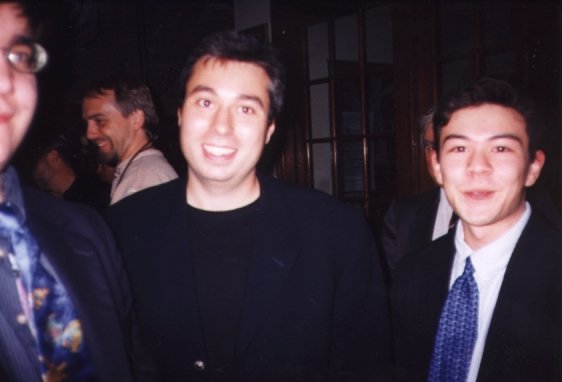
Chris Roberts at the premiere. Another fan in attendance wrote that “he seemed to be stressing that if he had had more money and time to spend on the movie, he would have made some changes.”
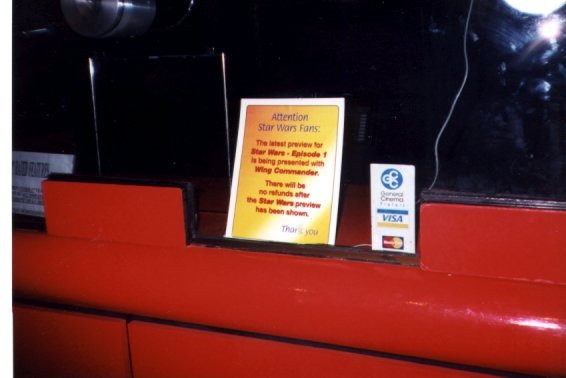
The general public was somewhat less enthused than our friends who saw the movie four times. These signs started to appear in theaters after it became a trend for patrons to buy a ticket, go in to watch the Star Wars trailer, then walk out and ask for their money back.
In light of the critical drubbing to which it was subjected and its modern-day status as a cinematic punchline, I watched Wing Commander: The Movie for the first time recently with, shall we say, considerable trepidation. My first reaction might serve as an argument for the value of low expectations: in many ways, it actually wasn’t as bad as I expected it to be.
The opening credits were snazzy and stylish, worthy of a far more respectable film. Even once the movie proper began, the production values and acting weren’t anywhere near as terrible as I had anticipated. This is not inexplicable: the belief shared by many fans that Wing Commander was an ultra-low-budget movie doesn’t hold water. As points of comparison, take the three vastly better received films which created and for a time cemented Freddie Prinze, Jr.’s standing as a teen heartthrob. I Know What You Did Last Summer, I Still Know What You Did Last Summer, and She’s All That all sported budgets well below that of Wing Commander; the last named, which was shot after Wing Commander but released before, had only one-third the budget of Chris Roberts’s film. Of course, none of these others were science-fiction films with a need for lots of fancy visual effects. Nonetheless, you don’t sign a heavyweight production designer like Peter Lamont, nor for that matter a potential star-in-the-making like Prinze, if you don’t have a certain level of connections and financial resources.
All of which is to say that, if you were to walk into a room where Wing Commander happened to be showing on the television, it wouldn’t jump out to you immediately as B-grade schlock in the way of, say, the notorious Plan 9 from Outer Space. The sets look good enough; the cinematography and sound design are perfectly professional; the acting doesn’t stand out for being awful either. In an ironic sort of way, all of this is a problem, for it means that Wing Commander manages to be just good enough to be merely boring and irritating rather than lovable in its sheer cluelessness.
My second big takeaway from watching the Wing Commander movie is closely related to my first: I was surprised at how similar it is to the computer games, after having heard legions of fans complain about just the opposite. There’s the same jarring bifurcation between the scenes of character interaction, which are shot like a conventional movie, and the ones depicting the action in outer space, which are completely computer-generated and, indeed, look very much like scenes from a game — a game, that is, made five to ten years after this movie was made. Likewise, there’s the same sense of a cast and crew of professionals doing their level best, knowing that what they’re creating is never going to be high art or even high entertainment, but feeling a craftsman’s responsibility to make the material come across as well as it possibly can. Nobody in film ever wants to be the weak link, even on a bad movie.
Rather than being awful on the face of it, then, Wing Commander is awful in a subtler way. Its problems all stem from the script, which doesn’t do the things that even popcorn-movie storytelling needs to do to be successful, and from its director’s baffling decisions about what parts of the script to leave in and leave out. A work of fiction — any work of fiction — is a clockwork mechanism beneath the surface. The author has to move her characters around in arbitrary ways to set up the plot beats her narrative requires. The art comes in making the mechanistic feel natural, even inevitable; at the risk of hopelessly muddling my metaphors, call it applying the flesh and sinew that are needed to conceal the bones of the story. In Wing Commander, said bones are poking out everywhere. The result feels so artificial that one is left looking for a stronger word than “contrived” to try to capture it.
Take the opening beats. The race of evil felines known as the Kilrathi attack a Terran Confederation flagship and secure — just to provide a note of contemporary relevance for those of us living in the third decade of the 21st century — an “AI” that can lead them to Earth, the location of which planet is for some reason unknown to them. This is an existential threat for the Terrans.
There’s just one ship that might be able to intercept the Kilrathi and report on their numbers and disposition before they make the jump to Earth: the outer-space aircraft carrier Tiger’s Claw. Unfortunately, it’s impossible for Terran High Command to tell this ship to do so because it is “beyond the reach of our communications.” (Presumably, the Tiger’s Claw’s radio will start working again before it’s time to send the report on the Kilrathi.) Luckily, a resupply vessel which can be reached is on its way out to the Tiger’s Claw. Even better, this resupply vessel is captained by one “Paladin,” some sort of special Terran “scout” who is only playing the role of the captain of an ordinary freighter. (What he or anyone else hopes to achieve by this deception is never explained.) Admiral Tolwyn, who stands at the head of the Terran High Command brain trust, such as it is, likes Paladin so much that he gave him his ring. (Isn’t that sweet?) Now, he needs only call up his favorite scout and tell him to tell the captain of the Tiger’s Claw to get a move on and intercept the Kilrathi.
Is this what he in fact does? No, reader, it is not. Instead Tolwyn remembers that the freighter happens to be ferrying a couple of young pilots fresh out of flight school over to the Tiger’s Claw. One of them is named Christopher Blair. Another Blair with whom he once served — now sadly deceased — was the kid’s father. “He was a good man,” Tolwyn says. On the basis of a zealous belief in eugenics, he elects not to convey the vital orders and intelligence to the grizzled special agent to whom he gave his ring but rather to the wet-behind-the-ears kid whom he’s never met.
It just goes on and on and on like this, with characters constantly making decisions that don’t make any sense. If you want your audience to become invested in your story, you have to provide them with a coherent internal logic that they can follow, no matter how outlandish your larger premise may be.
Another barrier to investment, likewise reflecting a bizarre lack of understanding of the fundamentals of this sort of fiction, is the yawning absence of a villain. Star Wars had Darth Vader; the best-ever Star Trek movie had Khan. Wing Commander has a few animatronic cats who spend less than five minutes onscreen and look absolutely appalling — and not in a good way — while they’re doing it; the Kilrathi are the one place where Wing Commander really does look like a B-movie through and through. To his credit, Chris Roberts was perceptive enough to see that it wouldn’t be a good idea to use the version of the Kilrathi from the games, actors in furry costumes who wound up looking more like cuddly department-store mascots or sports-team cheerleaders than a galaxy-enslaving force for evil. But what he was able to put in their place was not any better, as he also recognized. This explains why they got so little screen time: “The Kilrathi sucked and were basically cut out of the movie.”
A subtler, more aesthetically sensitive director might have spun our lack of eyes on the Kilrathi into a positive, turning their very mysteriousness into a sinister virtue in much the same way that the FreeSpace space sims did their evil aliens, the Shivans. Suffice to say that Chris Roberts was not such a director. The lack of an identifiable antagonist just emphasizes the sense of plot gears arbitrarily clanking around, oblivious to the requirements of compelling fiction. We see a lot of people fighting and dying, but we never know why or against whom or what. A popcorn movie without a villain just doesn’t work.
As for the heroes: this cast could have easily served the purpose if given a stronger script to work with. None of the young actors comes across as unlikable, but no actor could fully compensate for dialog as bad as this. “It takes balls — big balls, not ovaries — to keep track of four enemy fighters!” says Maniac, as the script desperately tries to interest us in a bantering will-they-or-won’t-they situation between him and one of the female pilots. Wing Commander is that guy at a party who thinks he’s hilarious and cool, whom everyone else just thinks is an annoying dweeb.
The image that springs to my mind now when I think back on Wing Commander: The Movie is one that nobody ever talks about. Early in the film, when he and Maniac are still aboard the tramp freighter, Blair has to plot a daredevil hyperspace jump because… Reasons. He does so, using what looks like a Casio calculator keyboard and some innate genetic talent that comes courtesy of his background as a “Pilgrim,” a whole other unnecessary and confusing thing in the script that I can’t be bothered to go into here. Anyway, he plots the jump, and just as it’s about to be made Maniac raises his hands above his head as if he’s riding a roller coaster. As he does so, you can see the most delicious expression on actor Matthew Lillard’s face: he looks all sorts of confused and bemused, as if wondering if this lame joke is really what he’s being asked to do here, even as he’s gamely trying to stay in character and look cocksure and pumped. He gets through the scene, the joke utterly fails to land… and Chris Roberts proceeds to put it in the final cut of his movie, no doubt sure that his audience will find it hilarious. It’s what the kids today call Cringe.
In a saner world, I would be able to end this article by telling you that all of the foregoing explains why Chris Roberts never got another sniff at a career in Hollywood. But he did, my friends… he did. Failing upwards is his superpower.

Our principal cast of hot young pilots. From left to right, Saffron Burrows plays Lieutenant Commander “Angel” Deveraux; Ginny Holder is Lieutenant Rosie “Sassy” Forbes; Mathew Lillard is Todd “Maniac” Marshall; Freddie Prinze, Jr., is Lieutenant Christopher “Maverick” Blair. (Is a case of Top Gun envy involved?) Of the four, Lillard makes the best of the bad situation and delivers the most energetic performance. Prinze mostly just stands around looking conflicted and earnest. “I tried to make him young and confused,” Prinze said when asked what he wanted to bring to the character. Exactly what every action-movie lead should aspire to be, right?
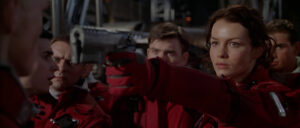
Devearux enforces discipline in her squadron by pulling out a gun and threatening to murder one of her pilots. None of her superiors aboard the Tiger’s Claw expresses any concern about this unhinged behavior. For all his obvious fascination with military culture, I’m not sure that Chris Roberts understands how it works.
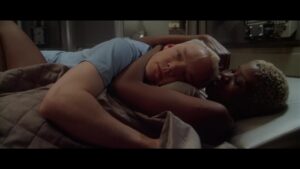
Maniac and Sassy consummate their romantic relationship with a lot of clumsy thrashing about without ever actually taking off their clothes. Thank God for small mercies. I shudder to think what a real Chris Roberts-directed sex scene would be like.

Oddly, it’s the veteran David Suchet who delivers the worst performance of the cast, constantly swinging between equanimity and rage for no apparent reason. I’m not sure I’d put Hercule Poirot in charge of a starship anyway.
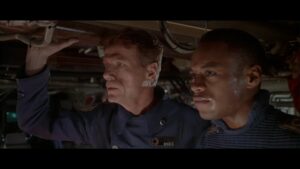
At one point, our World War II aircraft carrier in space suddenly turns into a submarine, complete with sonar pings and “Silence in the boat!” (never mind the soundless vacuum of space) and all the rest. Why? Because Chris Roberts thinks submarines are pretty cool too, that’s why. At least actor Jürgen Prochnow (left) had experience with this sort of thing…

Our space fighters, on the other hand, are decommissioned 1950s-era fighter jets when they’re at home in the hangar.

For the most part, the visual effects that were created by Digital Anvil while they were supposed to be making games for Microsoft aren’t terrible.
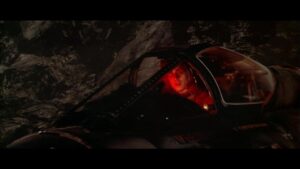
The special effects get themselves into serious trouble only when they’re blended with shots of the actors. Not coincidentally, videogames tended to have the same problem.
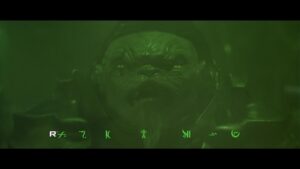
…or plastic, as in the movie? This is what is known as a Hobbes’s Choice. (There’s a dad joke in there for you old-school Wing Commander fans.)
There has to be someone else out there besides us. I hope they won’t be hostile, and I hope Earth is cool and doesn’t screw up first contact. No doubt our military will be there to greet them, defending the country. That’s not good. These aliens will come out, and they’re not going to be heavily armed because they’re not about that. We have to be mellow and peaceful. If that happens, it’ll be cool. But I don’t think it’ll happen that way. I think we’ll come hard, which is probably standard operating procedure. And that’s not a cool thing because we’ll probably get worked.
— Words of wisdom from Freddie Prinze, Jr., on the possibility of real extraterrestrial contact
Did you enjoy this article? If so, please think about pitching in to help me make many more like it. You can pledge any amount you like.
Sources: The book Generation Xbox: How Video Games Invaded Hollywood by Jamie Russell. Next Generation of March 1997; Computer Gaming World of May 1995 and June 1998; Starlog of May 1999, Austin Business Journal of March 2 1997, Texas Monthly of September 1997.
Online sources include “Chris Roberts explains what went wrong on the Wing Commander film” by Ben Kuchera at Penny Arcade, a 1998 Games On Line interview with Chris Roberts, a 2012 Chris Roberts “Ask Me Anything” from Reddit, a Microsoft press release announcing the Digital Anvil investment, the 1999-vintage Dan’s Wing Commander: The Movie Page (including the proprietor’s story of attending the premiere), and a 2002 Wing Commander retrospective by the German website PC Player Forever. I made extensive use of the Wing Commander Combat Information Center, and especially its voluminous news archives that stretch all the way back to 1998.
My invaluable cheat sheet for this article was “The Chris Roberts Theory of Everything” by Nick Monroe from Gameranx.
The Space Sim’s Last Hurrah
Amidst so much else, the 1990s saw the rise and fall of the narrative-driven space sim. The sub-genre was effectively invented in 1990, when Wing Commander dared to add a set-piece story line to the sturdy foundation of the more open-ended British classic Elite. It reached a peak of commercial and critical acceptance in 1994 with Wing Commander III and TIE Fighter, only to fall off the big publishers’ radar completely by shortly after the turn of the millennium. As you regular readers know, I’ve been writing the final installments to a lot of stories recently, a symptom of the period of churn and consolidation in which these histories currently find themselves. Now I’m on the verge of writing my last words on not just a company but a whole category of games as a mainstream commercial force — almost, I’m tempted to say, a whole subculture of gaming, one of the oddest of them of all when you stop to think about it.
Even the phrase “space sim” is kind of strange and misleading. What were these games supposed to be simulating? Definitely not any form of real spaceflight — not when they chose to implement atmospheric drag, meaning that your ship slows down if you let off the throttle in exactly the way that a real vehicle out in the vacuum of space doesn’t. Their developers started with the way space combat was presented in the Star Wars films, which had themselves happily ignored everything we know about the nature of real space travel in favor of dogfights borrowed from old Second World War movies. Then they just piled on whatever seemed fun and interesting to them, which often entailed delving deeper into the same wellspring as George Lucas. (It was no coincidence that Lawrence Holland, one of the foremost practitioners of the space sim, cut his teeth as a game developer on World War II flight simulators.) Space sims were known by that name because of their vibe alone — because they subjectively felt like simulators, no matter how divorced they were from the reality of space travel. (There are lessons to be drawn from this, if we choose to heed them. The fact is that almost every game which is labelled a simulator is less of one than it purports to be. This is worth remembering any time anyone encourages you to take any game too seriously as a reflection of the real world.)
Chris Roberts’s Wing Commander games made the space-sim formula still more uncanny, by interleaving the missions in space with potboiler relationship drama. It may have been weird on the face of it, seemingly more a product of some random butterfly somewhere flapping its wings than anything flown in on the wings of fate, but for the better part of a decade quite a lot of people loved it.
And then they didn’t so much anymore…
Being an inveterate hiker when I’m not sitting behind a computer, I can tell you that it’s sometimes harder than you think it ought to be to realize when you’ve reached peak elevation in a landscape. The same is true in the landscape of media. As I noted above, the space sim reached its peak already in 1994, even though it would take a few years for everyone to cotton onto that fact. For this was the year that both the Wing Commander series and LucasArts’s Star Wars space sims, the eternal yin and yang of the sub-genre, released their best-remembered installments.
Wing Commander III: Heart of the Tiger doubled down on creator Chris Roberts’s passion for the cinematic side of the experience by interleaving a fairly workmanlike space-combat game with a semi-interactive movie that featured digitized human actors, among them such established Hollywood talents as Jason Bernard, Malcolm McDowell, John Rhys-Davies, and Tom Wilson. In what was arguably the greatest feat of stunt casting in the history of games, the star of the show was none other than Mark Hamill. Over a decade after he had last portrayed Luke Skywalker on the big screen, he portrayed here another space-fighter jock, the player’s own avatar, Colonel Christopher Blair. The presence of so many recognizable actors garnered Wing Commander III considerable attention in the glossy mainstream press. The “Siliwood” dream of Northern and Southern California joining forces to forge a new form of entertainment was nearing its frenzied peak in tandem with the space sim in 1994. Wing Commander III was widely hailed, notwithstanding its computer-generated sets and general B-movie aesthetics, as a proof of concept for the better, richer interactive movies that were still to come. Hyped inside the industry as the most expensive game yet made, it garnered a rare five-stars-out-of-five review from Computer Gaming World, and sold at least half a million copies in the United States alone, at an average street price of about $70.
If Wing Commander III was trying to capitalize on gamers’ love for Star Wars in some less-than-subtle ways, LucasArts’s TIE Fighter had the advantage of literally being Star Wars, coming out of George Lucas’s very own games studio. It also had the advantage of being a much better, deeper game where it really counted, eschewing digitized actors and soapy relationship drama to focus firmly on the action in the cockpit. It too was given a perfect score by Computer Gaming World, and sold in similar numbers to Wing Commander III, albeit without attracting the same level of attention from the mainstream press.
Alas, it was mostly downhill for the two franchises from there; such is rather the nature of peaks, isn’t it? In early 1996, barely eighteen months after Wing Commander III, Chris Roberts and his employer Origin Systems were ready with Wing Commander IV: The Price of Freedom. Despite the short turnaround time, it represented another dramatic escalation in budget and ambition on the cinematic side of the equation. (The combat engine, with which Roberts by now hardly bothered to concern himself, was largely unchanged.) Mark Hamill and most of the rest of the previous cast were back, for a production that was shot on film this time rather than videotape, on real sets rather than in front of green screens that were filled in with computer-generated backgrounds after the fact. Yet many gamers found the end results to be paradoxically less stunning. The filmed sequences of Wing Commander IV fell into a sort of uncanny valley, being no longer clearly part of a computer game and yet having nowhere near the production values of even the most modest Hollywood features of the standard stripe. Probably more importantly, the Siliwood cultural moment was quickly passing, leaving the game with something of the odor of an anachronism. The mainstream was becoming more interested in the burgeoning World Wide Web than the wonders of multimedia and CD-ROM, even as hardcore gamers were embracing the non-stop action of the first-person-shooter and real-time-strategy genres, having lost patience with the long cutscenes and endless exposition of interactive movies.
For a cost of more than three times that of Wing Commander III, Wing Commander IV sold a third as many copies. Origin’s management told Chris Roberts that any future games in the series would have to scale back the movie angle and try harder to refresh the increasingly stale gameplay. By way of a response, Roberts quit his job at Origin.
From here, the decline was steep for Wing Commander. In September of 1996, the USA television network debuted Wing Commander Academy, a Saturday-morning cartoon featuring the voices of Mark Hamill, Malcolm McDowell, and Tom Wilson among other actors from the last couple of games. All of the parties involved had envisioned the show capitalizing on a hit game. Absent said hit, it disappeared from the airwaves after just thirteen episodes.
The franchise’s last hurrah as a game came with Wing Commander: Prophecy, which appeared at the end of 1997. “Wing Commander III and IV were both great products,” said Prophecy’s producer Adam Foshko, straining hard to be diplomatic toward his predecessor Chris Roberts, “but they are more like unequal halves. This is a much more synergistic product. It’s very team-driven. It’s not one person’s vision, and I think it shows.” At its best, Prophecy really did play better than any Wing Commander in years, evincing the far greater level of attention the team paid to the action in the cockpit. Less positively, the movie sequences were cheesier and more constrained, even as a plan to bring the game fully in line with the hardcore set’s current priorities by adding a multiplayer component ultimately came to naught. When Prophecy didn’t sell well, that was that for Wing Commander as a gaming franchise. The commercial prospects of an expansion pack that the team had been working on — a return to the old “mission disks” that had made Origin a bundle back before the former Luke Skywalker and his Hollywood friends had entered the picture — looked so dire that Origin just dumped the whole thing onto the Internet for free.
Meanwhile Lawrence Holland and his colleagues had been going through some travails of their own. After making a well-received TIE Fighter expansion pack and a “Collector’s CD-ROM” with yet more new missions to fly, Holland left LucasArts on amicable terms to start a studio called Totally Games, taking his technology and most of his team with him. From the average fan’s perspective, this was a distinction without a difference: Totally’s games would still be Star Wars space sims, and they would still be published by LucasArts.
Like their counterparts at Origin, the folks at Totally could totally see the potential in offering a multiplayer mode to keep up with the changing times. But unlike them, they stuck with the program. In fact, the next iteration of their series was designed to be multiplayer first and foremost. Holland and his people spent almost two years finding ways to make multiplayer work reliably despite all of the challenges of the high-latency, dial-up Internet of the era.
The result of those efforts landed with a resounding thud in the spring of 1997, becoming a case study in the dangers of failing to understand your customers. Holland’s X-Wing and TIE Fighter games may not have been interactive movies in the sense of Wing Commander III and IV, but people had nevertheless loved their unfolding campaigns, loved the sense of playing a part in what could easily have been a novel set in the Star Wars Expanded Universe. The ingeniously titled X-Wing vs. TIE Fighter didn’t give them any of that; its single-player mode was little more than a place to practice for multiplayer matches. “The sad part is, I was really looking forward to this game,” wrote Computer Gaming World’s reviewer, echoing the sentiments of thousands upon thousands of deeply disappointed ordinary players. “After the high of TIE Fighter, I wanted another Star Wars experience that would be just as immersive and fun. And while my wish for multiplayer Star Wars action was fulfilled, my hope for an equivalent single-player experience wasn’t.” In a last-ditch attempt to save their baby, Totally put together an expansion pack whose sole purpose was to provide a single-player campaign of the old style. It did so competently enough, but inspired it was not, and it never had much chance of rescuing a base game that was already a fixture of bargain bins by the time the expansion appeared in January of 1998.
In contrast to Wing Commander, however, LucasArts and Totally’s space-sim series was afforded one more kick at the can after 1998. To hear Lawrence Holland talk about it when it was still in development, Star Wars: X-Wing Alliance was the be-all, end-all in space sims. For those who wanted a story-driven campaign, this game’s would be the biggest and best ever. For those who wanted multiplayer action, this game’s multiplayer mode would be more stable and convenient than that of X-Wing vs. TIE Fighter. For those who cared about graphics, this game’s would be the best yet, taking full advantage of the 3D-accelerator cards that were proliferating everywhere. It was an ambitious plan, especially considering that this old-school Star Wars game had to be finished before The Phantom Menace, the first new Star Wars movie in more than a decade and a half, reached theaters in May of 1999, bringing with it an onslaught of next-generation toys and games.
X-Wing Alliance met that goal, being released in March of 1999. The most remarkable thing about it is how many of its other lofty goals it managed to achieve against the strictures of time and budget. The story is almost Wing Commander-like in its elaborateness, presenting for the first time a named, strongly characterized protagonist, a youthful member of a trading family caught between the Rebel Alliance and the Empire. His story is told not only through the usual mission briefings but also through emails and radio chatter full of enough interpersonal drama to warm the cockles of Chris Roberts’s heart. The campaign begins on the ice-planet Hoth, is interwoven with the events of The Empire Strikes Back and Return of the Jedi, and climaxes with you getting to fly the Millennium Falcon at the Battle of Endor. What dedicated Stars Wars fan could resist?
Sadly, further examination of X-Wing Alliance reveals some significant shortcomings. The individual missions are often unpolished, sometimes failing to even convey adequately what their goals are; trying to complete some of them feels like trying to read the designers’ minds. Ironically, this is the same general set of issues that dragged down the original X-Wing, upon which TIE Fighter did such a magnificent job of improving. It’s disheartening to see them making a return at this late date. Like so many flawed games, X-Wing Alliance might have been amazing if it had just been allowed a few more months in the oven.
That said, the biggest obstacle that X-Wing Alliance faced in the marketplace was probably just the tenor of the times. As I already noted, at a time when everyone was excited and optimistic about The Phantom Menace, the new face of Star Wars, this game was old-school. And yet that was only the beginning of the commercial headwinds it faced. Gamers in general were turning away from simulations in droves; real-world flight and combat simulators too, which had in some earlier years accounted for more than 20 percent of the computer-game industry’s total revenues, had now fallen markedly out of favor. Fewer and fewer gamers even owned joysticks anymore. (To what extent this was a cause and to what extent it was a symptom of simulators’ declining fortunes is a matter of debate.) Existing fans and would-be fans of simulations were being tempted away by other action-packed genres that were quicker and easier to pick up and play for the first time, while still offering plenty of long-term rewards for those who stuck with them. It seemed that fewer people had the patience for games that started by asking you to read a thick manual, then required you to go through a veritable digital flight school before you could start playing them for real.
At any rate, by Y2K both Wing Commander and the Star Wars space sims had been consigned by their publishers to the dustbin of history. Other titles in development that had dreamed of competing with the space sim’s dynamic duo head-on suffered the same fate. The most high-profile of the cancellations was a space sim from Sierra that took place in the universe of the recently concluded Babylon 5 television series. Created with heavy input from Christy Marx, a Babylon 5 scriptwriter who had earlier designed a couple of point-and-click adventure games for Sierra, it was supposed to “tart up a tired genre” and “radically change the face of gaming” with “non-linear, non-branching storytelling, a brilliant modular refit job on nearly five hours of [television composer] Christopher Franke’s music, plus an attention to the physics of space travel that will raise the high bar on space-combat games for years to come.” It got to within a few months of completion, got as far as having the box art prepared before falling victim in late 1999 to an uncongenial marketplace and to the chaos inside Sierra that had followed that venerable mom-and-pop company’s purchase by two separate corporate conglomerates in a period of just a few years.
Still, the space-sim diehards did get one last pair of classics from an utterly unexpected source before their favored sub-genre disappeared from the catalogs of the big publishers forever. In fact, many a grizzled joystick jockey will tell you even today that the second of the two Freespace games is the best of its type ever created — yes, better even than the hallowed TIE Fighter.
The first mover without whom Freespace would never have come to be was a native Chicagoan named Mike Kulas, whose early gigs as a game programmer included stints at subLogic of Flight Simulator fame and at Lerner Research, a precursor to the legendary Looking Glass Studios. At the latter workplace, he befriended one Matt Toschlog. “If this is what it means to run a company, we can do it too,” the friends decided after spending two years at the dawn of the 1990s on an ultimately unsatisfying racing game that was sold in the trade dress of Car and Driver magazine. “What’s the worst that could happen? It’ll fail and we’ll have to go back to work for somebody else.” Kulas and Toschlog moved out of the Boston area and back to Champaign, Illinois, also the home of subLogic. Champaign seemed a good place to open a new studio: it had the advantages of fairly cheap rents and a large pool of enthusiastic young tech talent, thanks to the University of Illinois Urbana-Champaign, the source of such innovations as the pioneering PLATO system of the 1970s and the point-and-click Mosaic browser that was popularizing the nascent World Wide Web at that very moment.
Kulas and Toschlog founded Parallax Software in June of 1993, six months before DOOM ignited a craze for immersive 3D action that would remake much of the industry in its image over the next few years. Luckily, Parallax was well-equipped to capitalize on the trend, what with the founders’ experience with 3D graphics and the passionate young sparks they were able to recruit from the nearby university. Descent, their very first game, put you behind the controls of a small flying vehicle and set you loose inside a series of 3D-rendered outer-space mining complexes, filled with robots gone haywire. It was different enough to stand out in a sea of DOOM clones, yet felt very much in step with the times in a broader sense. Upon its release in March of 1995, Descent became a surprise hit for its publisher Interplay, whose marketers were left scrambling to catch up to the buzz on the street with a port to the Sony PlayStation and television campaigns starring mid-tier celebrities. Made for less than half a million dollars, the game was one heck of a debut for Parallax. It and its almost-as-successful 1996 sequel were enough to make them think that winning fame and fortune in the games industry was actually pretty easy.
Matt Toschlog had never been happy in Champaign. Flush with all of that Descent cash, he wanted to move Parallax somewhere else. Mike Kulas, on the other hand, preferred to stay put. Unable to find any other way out of the impasse, the founders agreed to split the company between them. In late 1996, Toschlog moved to Ann Arbor, Michigan, to start Outrage Entertainment. Kulas decided to rename his half of the company Volition — “an intense act of will to accomplish something” — after stumbling across the word in a book. Outrage’s first project was to be the inevitable Descent3; Volition’s was to be Freespace, a space sim that would, as its name implied, take the player out of the asteroid mines and into the limitless inky-black freedom that lay beyond.
Freespace isn’t shy about displaying its influences. Created by a bunch of guys who adored LucasArts’s X-Wing and TIE Fighter sims, it hews unabashedly to their template. After the requisite flight training, you’re tossed into an interstellar war between your Terran Alliance and an alien race known as the Vasudans. Then another group of aliens shows up, a shadowy enigma that comes to be called the Shivans, who are so powerful that the old antipathies are quickly forgotten, and Terrans and Vasudans unite to face the greatest threat either of their races has ever known.
Although neither its core gameplay model nor its fiction is remotely revolutionary, Freespace stands out for how well it executes on this derivative material. The graphics are exceptional for their era, the possibility space behind the controls expansive, the mission design uniformly solid. Inspiration in game design is wonderful, but we should never forget the value of perspiration. The people who made Freespace loved what they were doing enough to sweat every small detail, and it shows. The only place where the game fell down a bit back in the day was a somewhat under-baked multiplayer mode.
Interplay insisted on calling the game Descent: Freespace (“From the creators of Descent!”) in the hope of riding the coattails of the publisher’s biggest hit in recent memory. Whatever else you can say about it, it certainly wasn’t their worst exercise in Descent branding. (That would be Descent to Undermountain, an ill-advised attempt to use the old Parallax engine for, of all things, a Dungeons & Dragons-licensed CRPG.) And who knows? Maybe the branding even did some good. Upon its release in June of 1998, Freespace sold well enough to be modestly profitable for its studio and publisher and convince Interplay to fund an expansion pack and a sequel. The only catches were that Volition had to turn both out quickly, without spending too much money on them.
The expansion pack, which they called Silent Threat, ended up being short and perfunctory, the definition of inessential. The full-fledged sequel, however, was a minor miracle. It defied every cynical expectation raised by its abbreviated development cycle when it shipped on September 30, 1999.
Freespace 2 — Interplay allowed the cleaner name this time, perhaps to avoid confusion with the recently released Descent3 — did everything its predecessor had done well that much better, then added a finishing touch that it had lacked: a real sense of gravitas, provided largely by the one significant addition to the development team. Jason Scott (not to be confused with the archivist and Infocom documentarian of the same name) was Volition’s first dedicated writer. He made his presence felt with a campaign that was sometimes exhilarating, sometimes harrowing, but always riveting. The outer-space kitty-cats of Wing Commander, even Darth Vader and Emperor Palpatine, paled in comparison to the Shivans after Jason Scott got his hands on them. “The universe is very impersonal,” he says. “Your character is referred to only as ‘Pilot’ or ‘Alpha 1,’ and you’re up against countless waves of a seemingly unbeatable, genocidal adversary that never communicates its goals or motives. In the briefings, we tried to convey the sense of a much larger conflict unfolding in multiple systems, while at the same time hinting that your commanders weren’t telling you the whole story.”
Freespace 2 was never going to single-handedly rescue the space-sim sub-genre, but it did ensure that it went out on a high note. It’s a demanding game even by the usual standards of its kind, one that uses every key on the keyboard and then some, one that is guaranteed to leave you wishing you had more buttons on your joystick, no matter how nerdily baroque it might already be. Some of its more counter-intuitive commands, such as “target my target’s target,” have become memes in certain circles. Yet the developers are unapologetic. “We wanted players to feel like pilots in control of a complex, powerful, responsive, and technologically advanced machine,” says Jason Scott. “Complexity was a virtue.”
I’m almost tempted to write here that this was a shame, in that it put such a high barrier to entry in front of what was actually one of the more sophisticated ludic fictions of its era. My experience with the game probably isn’t unique: I struggled with it for a while, reached a point where I couldn’t seem to hit any enemy that I shot at even as said enemies had become all too good at hitting me, and wound up watching the rest on YouTube, as you do these days. On the other hand, though, why shouldn’t unabashedly demanding games that aren’t quite for me have good writing too?
Because you deserve to hear from someone other than a dabbler like me before we move on, I’m going to take the liberty of quoting Lee Hutchinson, who is a good friend of this site, a stalwart voice of reason in these increasingly unreasonable times of ours through his day job as a senior editor at Ars Technica, and, most importantly for our purposes, a hardcore space-sim junkie in all the ways that I am not. He can explain better than I can what Freespace 2 came to mean to its biggest fans, how it melded gameplay and narrative into an unforgettable roller-coaster ride.
If you’ve seen one of those simplified “evolution of man” charts, showing a chimp-like predecessor far at the left and an upright tool-using human all the way at the right, you’ve got a good idea of how Freespace 2 capped off the genre. It was the culmination of everything that had come before it, and every single gameplay element was refined and polished to a razor-sharp gleam.
Freespace 2 lets players experience a tremendous variety of missions in different fighters with a gamut of capabilities. Each mission is connected by an overarching plot: you may be ambushed while escorting some capital ships in one mission, and then in the next mission you might switch to flying a bomber and be assigned to take those capital ships out. You might be temporarily attached to a special-operations wing flying a prototype starship, or have to fly captured Shivan fighters in a deep-cover mission to scope out an enemy staging point, or deal with total mission failure and objective changes right in the middle of doing dozens of other things. Capital ships fire ridiculously large, ridiculously powerful beam weapons at each other, slicing each other to ribbons and providing a fantastic Babylon 5-esque backdrop while the player duels enemy fighters.
The targeting system is complex and rich; the wingman and escort system is complex and rich; the comms system is complex and rich. Everything about Freespace 2 shows care, love, and craftsmanship — from the chatter going back and forth between your wingmen as you blindly scout a nebula looking for a lost frigate, to the amazingly well-acted mission briefings. In practically every way, it is the Platonic ideal of a space-combat sim.
Starting at about the halfway point, Freespace 2 drops the hammer on the player with a series of tightly linked missions that absolutely do not let up. The war against the Shivans isn’t going well. A faction of Quisling-like humans is trying to defect to the Shivans’ side, taking a large chunk of the human military with it. At several points throughout the long campaign, it feels like the game is about to come to a crashing climax — only it doesn’t end. Things just get worse, and it’s an absolute rush to experience — flying your guts out, desperately trying to fight a rear-guard action against an unknowable enemy that seems to be totally unable to feel remorse, pity, or even fatigue.
I’ve never felt quite the combination of awe, fear, and eagerness I felt as I pushed through to Freespace 2’s endgame. There are lots of gaming experiences I wish I could relive for the first time, but playing Freespace 2 tops the list. That’s as good a way as any to judge a game as the best in its genre.
In the short term at least, Volition wasn’t rewarded very well for creating this game that Lee Hutchinson and more than a few others consider simply the best story-driven space sim ever made, the evolutionary end point of Chris Roberts’s original Wing Commander of 1990. Mike Kulas insists that Freespace 2 didn’t actually lose money for its studio or publisher, but it didn’t earn them much of anything either. Plans for a Freespace 3 were quietly shelved. Thus Freespace 2 came to mark the end of an era, not only for Volition but for computer gaming in general: while not quite the last space sim to be put out by a major publisher, it was the last that would go on to be remembered as a classic of its form.
What with there being no newer games that could compete with it, those who still loved the space sim clung all the tighter to Freespace 2 as the months since its release turned into years. They were incredibly lucky that Volition was staffed by genuinely nice, fair-minded people who felt their pain and were willing to “pay it forward,” as the saying goes. In 2002, Volition uploaded the full source code to Freespace 2 to the Internet for non-commercial use.
They couldn’t possibly have envisioned what followed. As of this writing, 23 years after that act of spontaneous generosity, the Freespace 2 engine has been improved and modernized almost beyond recognition, with support for eye-bleedingly high resolutions and all of the latest fancy graphical effects that my humble retro-gaming computers don’t even support. You can use the updated engine to play Freespace 1 and 2 and the Silent Threat expansion pack, in versions that have been polished to an even shinier gleam than the originals by the hands of hundreds of dedicated volunteers. Even more inspiringly, folks have used the technology to create a welter of new campaigns — effectively whole new space sims that run off what remains the best of all engines for this type of game.
The people who made Freespace 1 and 2 all those years ago are themselves awed by what their pair of discrete boxed computer games have been turned into. Freespace proved to be as much a new beginning as an ending. Long may the space sim fly on in the hands of those who love it most.
Did you enjoy this article? If so, please think about pitching in to help me make many more like it. You can pledge any amount you like.
Sources: Sierra On-Line’s customer newsletter InterAction of Spring 1999; Origin Systems’s internal newsletter Point of Origin of September 20 1996 and February 14 1997; Computer Gaming World of October 1994, February 1995, July 1997, April 1998, October 1998, November 1998, February 1999, July 1999, and January 2000; Retro Gamer 204.
Online sources include interviews with Jack Nichols and Randy Littlejohn on B5 Scrolls, “Growing Up Gaming: The Five Space Sims That Defined My Youth” by Lee Hutchinson at Ars Technica, an interview with some of the core members of the Freespace 2 team by the Space Game Junkie podcast, and a Game Informer documentary about Volition’s history.
Where to Get Them: Wing Commander I and II, Wing Commander III: Heart of the Tiger, Wing Commander IV: The Price of Freedom, Wing Commander: Prophecy, X-Wing, TIE Fighter, X-Wing vs. TIE Fighter, X-Wing Alliance, Descent: Freespace, and Freespace 2 are all available as digital purchases on GOG.com.
I strongly recommend that you run the Freespace games through the Freespace Open engine, even if you’re primarily looking for a retro experience. Both on native Windows 10 and running through WINE on Linux, I found the original Freespace to be subtly broken: I was given only a fraction of the time I ought to have been given to complete the last training mission. (This was not good at all, considering I’m rubbish at the game anyway.) Freespace Open is quite painless to install and maintain using a utility called Knossos. It will walk you through the setup process and then deliver a glitch-free game, whilst letting you select as many or as few modern niceties as you prefer.





